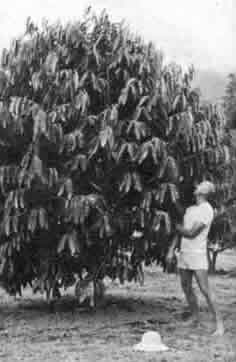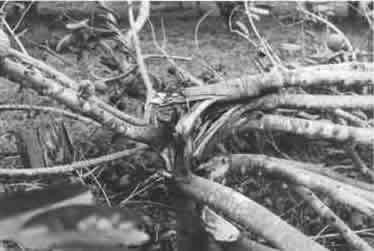From the Archives
of the Rare Fruit Council of Australia
by Christine Gray

The Survival of the POSH-TÉ
Scientific Name: Annona scleroderma
Family: Annonacaea

Don inspecting the posh-té tree, 12 months before cyclone "Joy", December 1989.
December 24th 1990 was a
Christmas Eve we will not forget in a hurry. Cyclone "Joy" came close
to Cape Tribulation and hovered off the coast of Port Douglas for two
and a half days.The force of the
cyclone badly hit parts of Cape Tribulation where our friends Colin and
Dawn Gray lost an entire crop of rambutans, 60% of their durian fruit,
with a third of their fruit trees badly damaged - the winds snapping
major branches and trunks.It must
have been a joke in the weather department to name a cyclone at
Christmastime "Joy" (we all felt joy when at last the cyclone petered
out into a rain depression.)The gusts
of wind from cyclone "Joy" hit Mt. Lewis near Julatten and then
continued to blast our area. The rain was actually coming down
horizontally with the force of the wind. The wind gusts were not as bad
as cyclone Winifred, though. Don did not cut any trees back. We had
just come through a drought. No rain had fallen for eight months. The
ground was dry and the trees had dropped a lot of foliage except the
posh-té and a few others. Don had been only watering the smaller trees.
Don believes that one can overwater the large trees, making them weak
and unable to stand against any wind or drought, because holding back
on the water forces the roots to go deeper.Cyclone
"Joy" brought us the rain we needed and broke the drought. The winds
ceased Christmas morning. We walked out into the orchard to see the
damage.

The posh-té tree after cyclone "Joy", 24.12.1990
On
the ground lay the shattered remains of the original grafted posh-té.
Two branches of the posh-té were still attached to the stump, with a
couple of fruit attached (the tree later died and the stump was
removed). The posh-té tree is such a beautiful tree with dark green,
shiny, abundant foliage - which is not good when a cyclone is around.
The tree, being heavy with foliage and extra weight from rain water,
soon gave way as the winds tore it to bits.
Luckily, Don had
planted out other posh-té trees in different areas, and only one other
was blown out and another lost a huge branch. We were thankful, as
overall only 20 trees were lost.
It really pays to have the same
type of tree planted in different places on one's property, as cyclones
seem to move around in belts of wind and can miss a lot of trees.
Before
cyclone "Joy" we had picked quite a good crop of posh-té fruit. On 24th
October, 1990, I measured a good-sized fruit. It weighed 500 grams,
measured 33cm or 13 inches in circumference, 10cm or 4 inches in
diameter. The thickness of the skin or hard shell was 2mm, or just over
1/16 inch.
Betty arrived at our place one Sunday and volunteered
to taste-test a chilled posh-té fruit. Her comments were, "It doesn't
look much", as we cut the fruit in half for her to try. "But it is
what's inside that counts," Betty added. Tasting the fruit, Betty said,
"The fruit has a ginger, lemon flavour, moist, not grainy and not
distasteful at all, there is a lot of flesh, nice!" Betty commented.
"The more I eat, the more pleasant it is," Betty added.
We have found the posh-té fruit left a pleasant aftertaste in one's mouth. The fruit is much nicer chilled.
We
have found the best time to eat the fruit is when the markings on the
fruit have smoothed out. The flesh tastes better when it is clear. The
amount of flesh in the fruit is deceiving, as the seeds seem to take up
hardly any space, and the seeds come out of the flesh clean and easy.
I
was asked by David Wallace, "Have the flowers any perfume?" On the
afternoon of the 24th February, 1991 at 3 p.m., Barbara, our Daintree
fruit-growing enthusiast and I decided to check out the posh-té
flowers. We took a close whiff of a female flower; the stigma was moist
and just barely opening. We agreed that the smell was like acrylic
paint. So I wonder if this smell is to attract certain pollinating
insects, or if the posh-té is pollinated by the air currents moving
around the pollen and sticking to the female flowers. It may be a bit
of both. There are still flowers opening, the date is now 11th March,
1991.
Picking our posh-té fruit started in October. We were up
at Colin and Dawn Gray's at Cape Tribulation in October and inspected
the posh-té tree Don had supplied to Colin. Their tree was in flower in
October, so there is quite a few month's difference in flowering from
coast to Julatten on the Tablelands. Our posh-té tree flowers from
January to March.
One other thing we noticed was, when the fruit
set, they set on branches in small clusters of two or three fruits.
This causes smaller fruit to form. Thinning out the fruit would be a
good practice to adopt, to encourage larger fruit.
Because there were too many fruit on the tree, quite a few turned black and went hard - they were mainly the smaller fruit.
Towards
Christmas, before cyclone "Joy", a number of posh-té fruit we opened
had fruit fly. Fruit fly are active and breed in hot, humid weather.
The
posh-té fruit is really a surprise fruit. One has to know exactly when
to eat them. Because if you eat them too early, they are sour, or if
you eat them too over-ripe, they are mushy; but just right, they are
delicious.
The posh-té is a tree worth including in one's
backyard collection. The fruit could have commercial potential, but one
would have to consider the fruit fly.
Back to
Poshte Page
|
|


